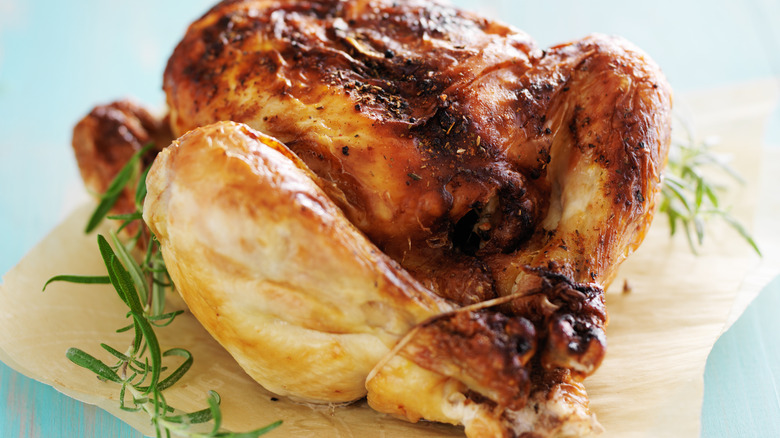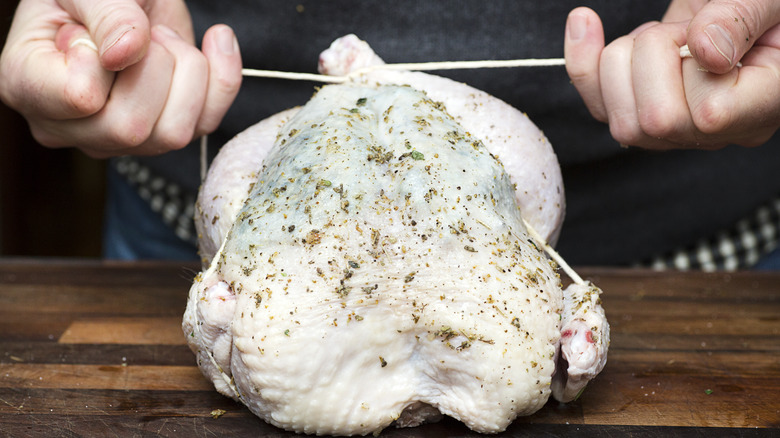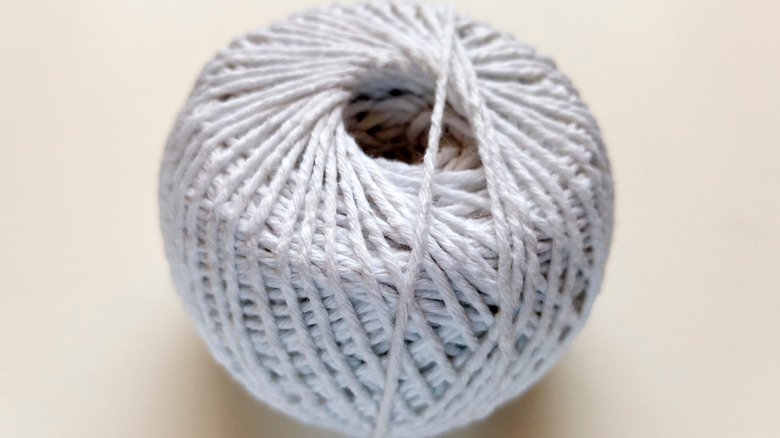The Best Kind Of Twine For Trussing Birds
Every kitchen should be capable of helping its cooks produce exemplary dishes without the use of any special equipment. We're talking sharp, well-maintained knives, oiled cutting boards, properly-seasoned skillets, and... a spool of string? It might sound outlandish, but the correct kind of twine can be an incredibly practical addition to your culinary arsenal. You can hang meats while they cure and smoke, string up cheeses while they age, or give new life to old herbs by drying them.
The Los Angeles Times explains that you can also do smaller-scale things with twine, like bundling aromatics and spices for your sauces and soups, closing up sausages, and even plumping up steaks so that they cook more evenly on a hot grill. But by and large, one of the most well-known ways to use twine in the kitchen is to tie up meat dishes, including trussing. So what exactly is trussing, and what string should you keep handy for it?
What is trussing?
MasterClass defines trussing as a culinary technique that involves binding a whole chicken (or other bird) with twine to keep the legs and wings near the bird's body. This permits more consistent cooking, which translates to moist meat and crisped-up skin because you're essentially sculpting the bird into a more manageable form. As such, you'll also see twine come into play when making other roasts for the same reason.
Traditional trussing involves tying the chicken around its legs, wings, pope's nose (tail region), and neck area. This way, these extremities won't burn and dry out, and you'll have a glorious eating experience for white and dark meat. You'll often see rings of food-grade plastic used in this manner for store-bought rotisserie chickens. Of course, you can also forgo the twine entirely if you've got a big enough bird with ample skin, like a turkey — but if you choose to truss a big bird, don't truss too tightly to avoid drying out the breast.
Twine tips and tricks
Broadly speaking, you'll want a string that's marketed as butcher, cooking, or kitchen twine, according to WebstaurantStore. They're made from natural fibers, either by themselves or in blends. WebstaurantStore explains that white cotton twine is a solid choice: tough, inexpensive, environmentally friendly, and safe for use with raw foods and even high-heat cooking. They also suggest hemp twine, strong linen twine (especially for knot-tying and hanging), rough brown jute twine (though not for hot applications), and some types of uncolored, thick polyester twine. WebstaurantStore also reminds us that industrial polypropylene twine is not food-safe.
Aside from trussing birds, there are plenty of ways to utilize cotton twine in your kitchen. A tidily-tied roast holds on to its fillings and its moisture alike, and cured meats that are tied and hung up are easier to cut and have ample airflow for the aging process. Cotton twine is also great for keeping boxes closed and bundling ingredients together. The Los Angeles Times recommends soaking your twine prior to high-heat cooking so it won't burn, and reminds cooks to remove any string before serving a finished dish, because as useful as it is, twine's not good to eat.


